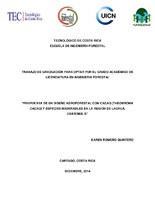Mostrar el registro sencillo del ítem
Propuesta de un diseño agroforestal con cacao (theobroma cacao) y especies maderables en la región de Lachuá, Guatemala
| dc.contributor.author | Romero-Quintero, Karen | |
| dc.date.accessioned | 2015-03-10T16:57:13Z | |
| dc.date.available | 2015-03-10T16:57:13Z | |
| dc.date.issued | 2014 | |
| dc.identifier.uri | https://hdl.handle.net/2238/3932 | |
| dc.description | Proyecto de Graduación (Licenciatura en Ingeniería Forestal) Instituto Tecnológico de Costa Rica, Escuela de Ingeniería Forestal, 2014. | es |
| dc.description.abstract | A proposed for an agroforestry design with cocoa and timber species was performed in the region of Lachuá, Guatemala; for this, the areas available for the potential establishment of new SAF was evaluated within the region, where 20 farms where randomly selected for taking soil samples. Each farm was stratified by homogeneous area according to land use and / or slope and a composite soil sample was obtained, that underwent a complete chemical analysis, however, for purposes of this study only pH, OM and Al was considered. Similarly, for each sample, texture was determined and terrain slopes for each of the analyzed sites were taken and the current land use was described. In addition, possible plant species to use within the SAF were socially defined by five workshops developed in different communities. With the previous information, a design of agroforestry system was proposed, where species that are better suited to the environmental characteristics of the region were selected. Finally, trade volume was estimated to obtained timber species to be used in the system using the Smaliam, FAO, Rivas and Zetina formulas. The evaluated sites have different land uses, where thickets and corn crops predominate. Slopes range from 3% to 60%. Meanwhile, analyzed soils are acidic soils, with a pH ranging between 4,6 and 6,6; also contain a wide range of organic matter. Furthermore, most of the evaluated sites have a clay texture. Some of the plant species mentioned most frequently in the workshops were Swietenia macrophylla, Cedrela odorata, Inga sp., Gliricia sepium, Dialium guianense and Brosimum alicastrum. Two designs in square and two designs in staggered are proposed for the SAF, where the plant species propose for the design with the cacao are Musa sp., Gliricidia sepium, Swietenia macrophylla, Cedrela odorata, Genipa americana, Pithecellobium arboreum, Cordia alliodora, Terminalia amazonia and Vochysia guatemalensis. At 15 years, you can obtain a trade volume of 0,46 m3/tree for Terminalia amazonia, 0,95 m3/tree for Vochysia guatemalensis and 0,53 m3/tree for Cordia alliodora. At 30 years, you could obtained 1,53 m3/tree for Swietenia macrophylla; 2,15 m3/ tree for Cedrela odorata; 2,23 m3/tree for Pithecellobium arboreum and 1,75 m3/tree for Genipa americana. | es |
| dc.description.sponsorship | Instituto Tecnológico de Costa Rica, Escuela de Ingeniería Forestal. | es |
| dc.language.iso | es | es |
| dc.publisher | Instituto Tecnológico de Costa Rica | es |
| dc.rights | acceso abierto | es |
| dc.subject | Especies vegetales | es |
| dc.subject | Sistema agroecológico | es |
| dc.subject | Volumen | es |
| dc.subject | Muestreo | es |
| dc.subject | Suelos | es |
| dc.title | Propuesta de un diseño agroforestal con cacao (theobroma cacao) y especies maderables en la región de Lachuá, Guatemala | es |
| dc.type | proyecto fin de carrera | es |


